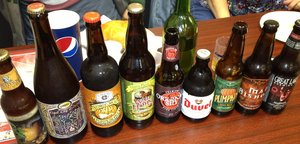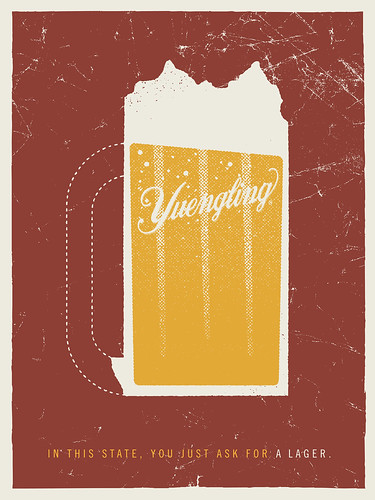Tonight was beer club, a meeting of beer minded individuals from my work who get together once a month to share good beer, a good meal, and good company! We typically congregate at a local BYOB, and this time we hit up America’s Pie, probably the best pizza joint in West Chester. Lots of food and beer and mirth was had by all. Things started small but grew as the night progressed, so this picture doesn’t quite capture all the beers that arrived later:
(Click for bigger image)
For the sake of posterity, some thoughts on each beer are below. As per usual, these beers were not consumed under ideal conditions, but hey, these were really fun conditions, which, come to think of it, are ideal enough for me. But you may want to take these notes with a giant rock of salt. Anywho, here’s the impressions I’m left with (in the order of drinking, not necessarily from the picture above):
- Lakefront Pumpkin Lager – A strangely muted flavor profile that features all the typical pumpkin pie flavors nonetheless, this was actually a decent way to start off beer club. Very aromatic, light, spicy, straightforward beer. Not going to light the world on fire, but a worthy brew. B
- Duvel – This is generally considered to be a classic beer, but I have to admit, I’ve always come away somewhat underwhelmed by Duvel. I feel like this bottle was much better than any of my previous tastings. Sweet, spicy Belgian yeast character in the nose and taste. Last time I had this, I was a little turned off by what I perceived to be tart, lemony notes, but that didn’t appear to be in tonight’s bottle at all. Strange. I still wouldn’t call this one of my favorites or anything, but I could bump it up to a B
- Original Sin Hard Cider and Dana’s Homemade Applewine – I tend to call this event “beer club”, but lots of other alcoholic beverages make appearances. This usually amounts to wine, but some folks who don’t like beer will go for some cider too (especially this time of year, I guess). Me, I don’t really care for that sort of thing. I tried a couple offerings and thought, yep, that’s got apple flavor, and left it at that.
- Cigar City Guava Grove – One of my contributions for the night, this is a big, delicious ball of spicy, fruity saison goodness. Great orangey color, spicy Belgian yeast character in the nose and taste, with a level of fruitiness, presumably coming from the guava. Generally considered to be the best beer of the night, I jokingly mentioned that I wished I kept it all for myself. But I kid. Anywho, exceptional beer. I really must figure out how to get my hands on some more Cigar City stuff. A-
- War Horse India Pale Ale – Probably suffered a little in comparison to the Guava Grove, but yeah, it’s an IPA, focusing on the earthy, floral notes, with a strong malt backbone and a fair bitterness in the finish. I found it to be somewhat unremarkable, but it was generally enjoyed by the group (we are easily amused). B-
- DuClaw Mad Bishop – Ah, it was about time someone broke out the other major seasonal style, the Oktoberfest. Not one of my favorite styles, but as these things go, I found myself enjoying this one quite a bit. It seemed a little sweeter than your typical, authentic examples of the style, but that’s not a horrible thing in my book. Very nice. B
- Lindemans Framboise – Another offering that was popular with the cider/wine crowd, I found it a little on the cough syrupy side of things. Nice raspberry flavors and it’s pretty thick and sweet for such a tiny ABV beer, but I don’t know, maybe I’m spoiled by better lambics at this point. B-
- Great Lakes Nosferatu – This is one of them Imperial Red Ale beers that goes heavy on the citrus and pine hops, certainly a welcome development at this point in the night. Even with my palate probably being in pretty bad shape, I found this to be quite good. And you’ve just gotta love the label/name of this beer too. I should pick up a bottle of the stuff and give it a fair shake, though I’ll still hand it a B+ rating, making it one of the better beers of the night.
- Lagunitas New Dogtown Pale Ale – One of those late arrivals, this one actually held its own against some of the bigger beers I’d been drinking. Big citrus and pine character in the nose and taste, making it seem more like a straight up IPA than a lowly Pale Ale. Quite enjoyable and again, one of the better beers of the night. B+
- St. Bernardus Tripel – Another beer I’ve actually reviewed before, though this time my feelings on the beer haven’t changed much. I didn’t have a lot of it tonight, but it’s pretty much exactly what I remember about it. Excellent Belgian Tripel, if not quite my favorite.
- Yuengling Oktoberfest – At this point in the night, my palate is pretty well wrecked, but again, it seemed like a really solid, traditional take on the Oktoberfest style. Not exactly my thing, but I could probably put a few of these down in a session if duty called for such. Indeed, I might even prefer this to the ubiquitous Yuengling Lager… B
- Lavery Stingy Jack Pumpkin Ale – My other contribution for the night, I think this one comported itself quite well. It’s got that big, chewy pumpkin pie thing going on here, but the balance of malt, pumpkin, and spice was pretty well honed here, as I really enjoyed it. Now, again, I was pretty well in the bag at this point, but the bomber I brought seemed to go pretty quickly, and folks seemed to enjoy it. I’ll give it a provisional B+
Phew, that ended up being quite a list of beers. Oddly, they were all pale colored – not a single stout to be had. The closest thing to a dark beer was Nosferatu, which probably couldn’t be counted as pale, but it’s no stout either. Not that I’m complaining. Indeed, I shall declare this gathering yet another success. I’m already thinking ahead to our next meeting…


